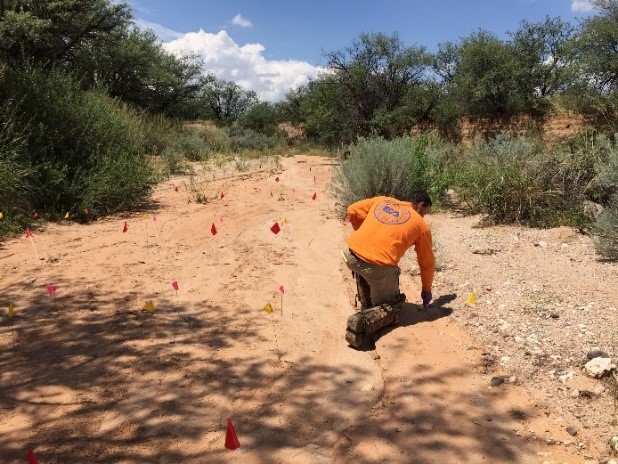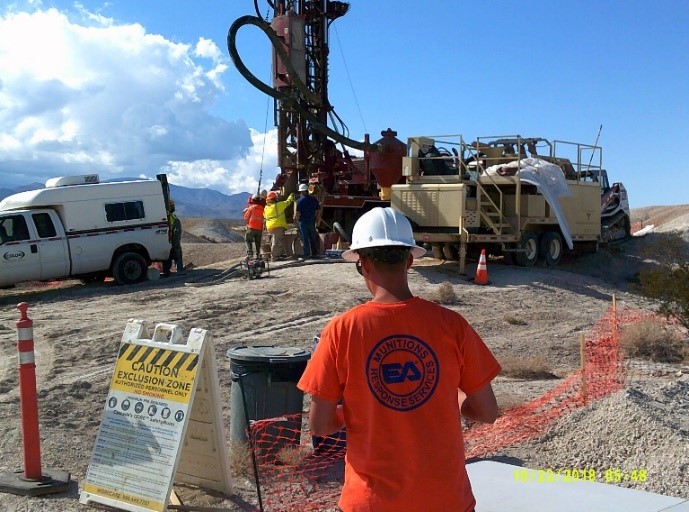 EA conducted a Phase III ORA (similar to a CERCLA remedial investigation/feasibility study) on the Air Force-owned Nevada Test and Training Range (NTTR) managed by Nellis Air Force Base near Las Vegas, Nevada. NTTR is one of the foremost testing and training ranges within the DoD arsenal and provides ground-to-ground, air-to-ground, and air-to-air training capabilities for all branches of the DoD and a variety of federal and local agencies.
EA conducted a Phase III ORA (similar to a CERCLA remedial investigation/feasibility study) on the Air Force-owned Nevada Test and Training Range (NTTR) managed by Nellis Air Force Base near Las Vegas, Nevada. NTTR is one of the foremost testing and training ranges within the DoD arsenal and provides ground-to-ground, air-to-ground, and air-to-air training capabilities for all branches of the DoD and a variety of federal and local agencies.
The goal of the Phase III was to determine if MC were migrating to off-range areas and, if so, are MC present at concentrations that pose a threat to human health or the environment. Based on the migration evaluation, the Phase III would also recommend mitigation measures to stop current and prevent future MC migration, if necessary. During the Phase III, NTTR was undergoing a contested land withdrawal in order to increase the acreage of the range including obtaining primary jurisdiction; as such, all collected data had the potential to assist in the acquisition. As part of the initial phases of the Phase III, the analytical data from the prior assessment were re-evaluated by EA. The re-evaluation of the data resulted in the analytical laboratory rescinding the explosives detections from the Phase II and reissuing the analytical data report showing no explosives detections in soil or groundwater.
 The Phase III investigation included the collection of various media including surface and subsurface soil, sediment, and groundwater samples. Soil samples were collected in on-range source areas including within current and historical air-to-ground targets requiring escort by UXO technicians as well as use of all-terrain vehicles. Of specific interest, soil samples were also collected within a Nuclear Regulatory Commission-licensed area requiring additional health and safety precautions in addition to UXO avoidance. Although MC were identified in on-range source areas, no migration to off-range areas via surface water/sediment was identified.
The Phase III investigation included the collection of various media including surface and subsurface soil, sediment, and groundwater samples. Soil samples were collected in on-range source areas including within current and historical air-to-ground targets requiring escort by UXO technicians as well as use of all-terrain vehicles. Of specific interest, soil samples were also collected within a Nuclear Regulatory Commission-licensed area requiring additional health and safety precautions in addition to UXO avoidance. Although MC were identified in on-range source areas, no migration to off-range areas via surface water/sediment was identified.
Groundwater samples were collected from production wells, existing and newly installed monitoring wells, and a capped spring. Due to the sensitive nature of testing and training at NTTR, EA worked with NTTR personnel daily to obtain access for onsite subcontractors. EA conducted a total of eight rounds of quarterly groundwater sampling over a 2-year period to account for seasonal variations in groundwater. Low levels of perchlorate were repeatedly detected in groundwater samples during the Phase III; as such, perchlorate speciation samples were collected from an on-range monitoring well and an off-range production well. Due to the large volume of water required to be passed through a resin in order to obtain adequate perchlorate, a submersible pump was run for 24 hours over several days within the monitoring well utilizing marine batteries and a solar array. The results of the perchlorate speciation indicated detected concentrations of perchlorate were naturally occurring rather than range-related. Overall, the Phase III determined that no MC were migrating off-range within groundwater.
